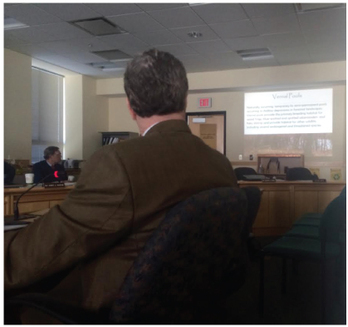 Mitchell Jones, PhD student, University of Maine
Mitchell Jones, PhD student, University of Maine
As a scientist in a family of some non-scientists I often find myself defending what I do for a living. At Thanksgiving and Christmas my cousins and in-laws always talk about what they’ve been doing at work. They’re from big cities—Boston, Washington, D.C., Philadelphia—and work in finance, editing, medicine, IT . . . the list goes on.
And then its my turn. I study how the development and infrastructure they live in and work for impact the natural world, specifically vernal pool amphibians in Maine. As I struggle to articulate how important it is to conserve non-exploitable natural resources, the reaction is mixed. Some are interested, but the inevitable groans about poorly allocated tax dollars soon overtake the conversation. This is my family.
When Dr. Aram Calhoun asked me if I wanted to join her on a trip to Augusta, Maine, to make this same argument to the Environmental and Natural Resources Committee at the State house, I jumped at the opportunity.
Aram has been pleading the case of the vernal pools and the abundance of life they support to the state for more than 15 years. She is arguably the biggest supporter of their protection. In fact, it’s in large part thanks to her that any protection exists at all. Aram has done her time in Augusta and knows the ropes—who to talk to, what to say, and how to work with lawmakers to come together. I was eager to watch and learn from her how we can bring what we do as scientists into the public sector to really make a difference outside academia.
On the drive down from Bangor Aram filled me in on the history of vernal pool protection laws, how hard and long they worked on the current law, and some of the finer points of how bills are introduced and passed in the State House. When we reached Augusta, she pulled a bag of books, pamphlets, DVDs and handouts out of the car—information about vernal pools to give to the legislators. (This information is also available at www.vernalpools.me.) Then, we went inside and headed to the committee room where she would be presenting about the basic ecology and importance of vernal pools.
After listening to a discussion of the bottle bill, it was time to talk vernal pools. The session was purely educational and no bills were being discussed, so after an introduction, some legal definitions, and a fight with the projector, Aram was off and running explaining why protecting vernal pools is so critical.
Some of her biggest points included:
- In Maine, the movement of amphibians to vernal pools every year is on a scale of the migrations of mammals across the African Serengeti.
- The amphibians and their eggs represent a massive food source for numerous animals in the Maine forests.
- Without protecting the areas around pools, we will lose the animals that live in them (as evidenced by many pools in Massachusetts in which only a 50 foot buffer was protected).
- Many species beyond amphibians (from moose to insects) use vernal pools as habitat.
 After the presentation there was time for questions, and it was like Thanksgiving dinner all over again. Some legislators were silent or not particularly engaged, but others were excited, asking questions to get a better idea of how to respond to upcoming legislation. They asked great questions on topics ranging from general biology to different resource management ideas.
After the presentation there was time for questions, and it was like Thanksgiving dinner all over again. Some legislators were silent or not particularly engaged, but others were excited, asking questions to get a better idea of how to respond to upcoming legislation. They asked great questions on topics ranging from general biology to different resource management ideas.
One legislator asked about the difference between directional buffers and circular buffers around vernal pools. This question was exciting to hear because it directly pertains to an area I plan to research, which means that my research could ultimately influence policy. Even more importantly, it means that the next time my cousin asks what I am up to these days, I can say “I am doing environmental research to help the Maine legislature make informed policy decisions about future development in the state.”
